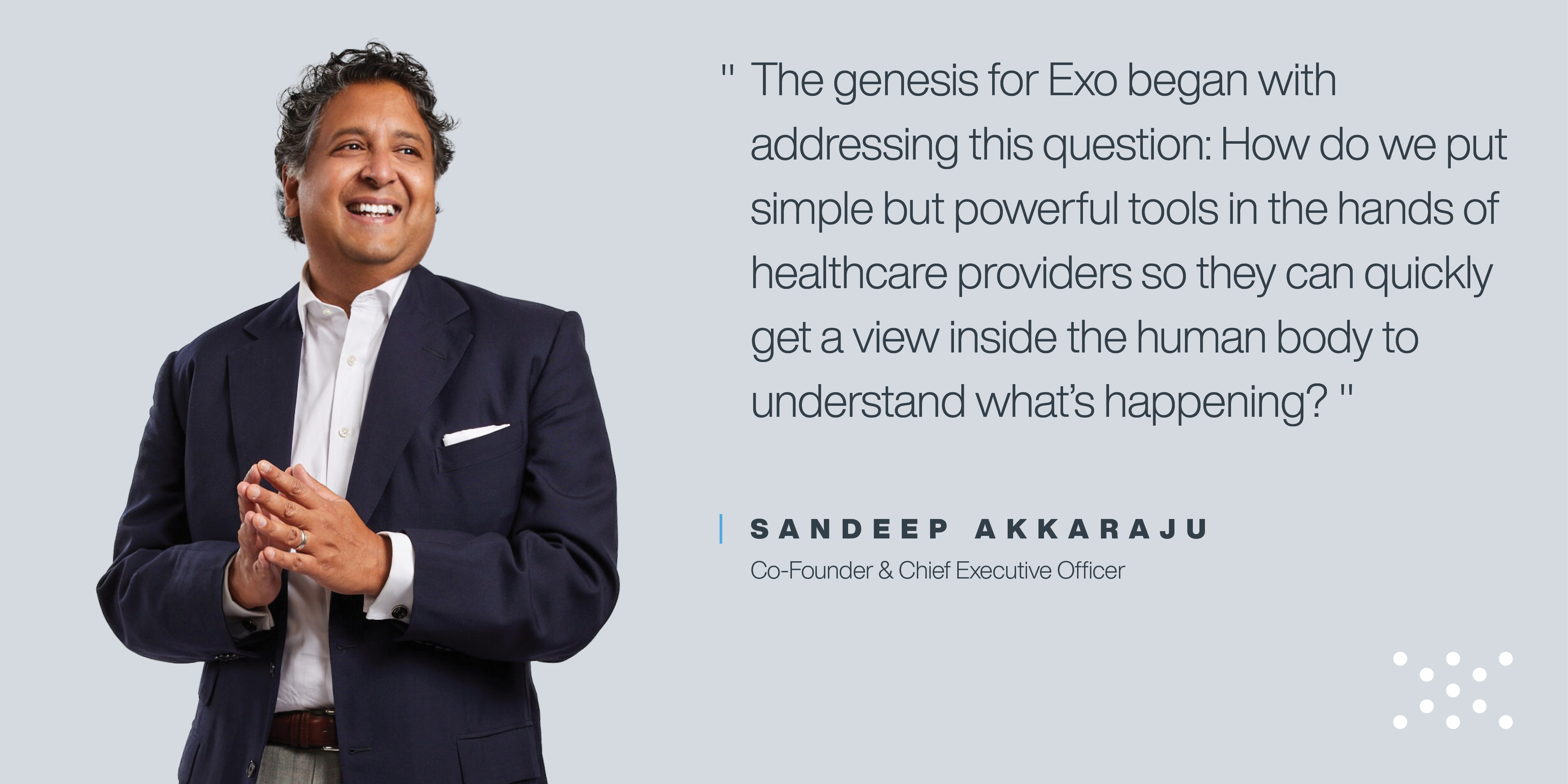Why the Future of Healthcare Depends Upon Streamlined Point-of-Care Imaging
Categories
Blog, Exo Works
Date
March 08, 2022
Source
Exo

Ever since the advent of the Internet, human connectivity has grown exponentially more mobile each year—think of how the cell phone untethered people from landlines, how email disrupted traditional letter correspondence, and how the smartphone has given humans the ability to map directions from anywhere. Yet until recently, this mobile-focused evolution has not largely impacted point-of-care imaging solutions in the healthcare space, such as ultrasound machines. An industry ripe for disruption, healthcare is full of patients and professionals around the globe who want more mobile-friendly solutions to address the burdensome experiences that they undergo when scheduling and receiving care.
In a recent VatorNews podcast episode, hosts Steven Loeb and Bambi Francisco Roizen spoke with Sandeep Akkaraju, Co-Founder and CEO of Exo, to address these very issues and the troubling fact that nearly 75% of the entire world’s population has no access to medical imaging. They explored how healthcare professionals and hospitals can harness the full potential of modernized point-of-care imaging to make healthcare more accessible worldwide.
Exo: A New Name for Ultrasound
Akkaraju explains that the future of healthcare depends upon making patient care more accessible and easier to perform. For something as critical as an ultrasound machine, it must be easy to scan, document, and bill. This challenge is why he founded Exo, a company dedicated to streamlining the ultrasound experience—all while improving its imaging quality.
“The genesis for Exo began with addressing this question: How do we put simple but powerful tools in the hands of healthcare providers, so they can quickly get a view inside the human body to understand what’s happening?” says Akkaraju.
This ease of use for ultrasound means letting go of outdated tools and features on traditional machines like knobs, sliders, track pads and trackballs. Can you imagine an ultrasound machine being as simple as using a smartphone camera? Exo aims to make this a reality. “We’re removing all of these buttons and controls to make ultrasound technology easier to use, increasing the number of medical practitioners who can use ultrasound,” shares Akkaraju.
Exo’s goal is to get its devices and software into the hands of every medical practitioner, giving physicians and nurses a window to see clearly into every patient immediately.
The Most Advanced Ultrasound Silicon In the World
Ultrasound technology hasn’t significantly changed for more than half a century. While ultrasound devices remain expensive, they also remain complex to learn and use. The aim is simple: to create more equitable patient care by converting this high-cost, complex equipment into something that is affordable, easy-to-use, and fits into your pocket — so you can take it anywhere.
By challenging the fundamental science and physics of ultrasound technology, Akkaraju shares that Exo has created a new proprietary ultrasound system composed of nanotechnology with a cutting-edge chip design that acts as a “supercomputer” to pack the highest imaging performance into an affordable handheld device.
In a world where patient care can be delivered beyond the hospital’s walls, the time has come for stationary cart-based ultrasound systems to evolve into powerful handheld devices that medical practitioners can easily carry with them on the go. And to achieve this next generation of imaging equipment demands a software-based approach—which is where Exo’s ultrasound POCUS workflow software platform called Exo Works™ comes in.
A Solution to a Challenging Problem
When Akkaraju began designing Exo’s flagship ultrasound device, he and his team happened upon a wider, more serious issue hindering healthcare professionals in serving their patients: workflow issues surrounding imaging. To perform point-of-care ultrasound, it’s not as simple as turning the machine on. Patients must first get in line behind others who need the equipment, and sometimes that line can be months long. After a healthcare professional performs the ultrasound imaging, patients must wait for ultrasound documentation and billing to fully complete their procedure.
As Akkaraju describes it, Exo Works combines exam review, documentation, and billing into a single platform for efficiency. And it works with nearly all point-of-care ultrasound devices. When combined, these areas streamline the ultrasound process so that waiting lines decrease, billing issues diminish, and healthcare professionals can focus their time on doing what they should be doing: serving patients.
The Future of Healthcare, Today
In the end, it’s about customer empowerment, which drives down healthcare costs both for the provider and patient. New approaches to point-of-care completely reshape the role of the modern doctor: to do more for patients, wherever they are.
Learn more here to see how Exo Works is revolutionizing point-of-care ultrasound workflow.